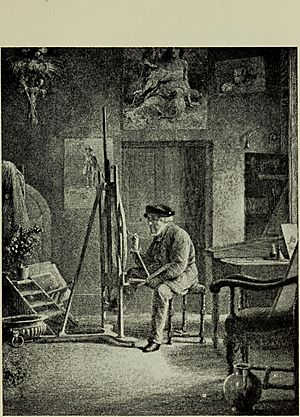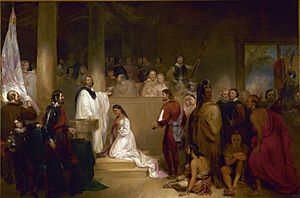John Gadsby Chapman facts for kids
Quick facts for kids
John Gadsby Chapman
|
|
|---|---|
 |
|
| Born | 11 August 1808 Alexandria |
| Died | 28 November 1889 Brooklyn |
| Occupation | Artist |
| Style | Italianization, history painting, genre painting, portrait |
| Children | Conrad Wise Chapman |
John Gadsby Chapman (born December 3, 1808 – died November 28, 1889) was an American artist. He is most famous for his painting Baptism of Pocahontas, which you can see in the United States Capitol rotunda in Washington, D.C. The United States Congress asked him to paint this important artwork.
Contents
John Gadsby Chapman's Life and Art
Early Life and Training
John Chapman was born in 1808 in Alexandria, Virginia. He started studying art in Philadelphia for two years. After that, he traveled to Europe, where he spent time in Italy learning more about art.
In 1831, Chapman came back to Alexandria. He showed his paintings in nearby cities like Washington, D.C., Richmond, and Philadelphia. He was especially good at painting landscapes (scenes of nature) and portraits (pictures of people).
Famous Paintings and Illustrations
By 1834, Chapman had moved to New York City. He became a member of the National Academy of Design, which is a group for artists. He also found work as an illustrator, drawing pictures for books and magazines.
In New York, Chapman began painting historical scenes. Some of his famous works include Landing at Jamestown and Crowning of Powhatan. These paintings were very successful. Because of this, the United States Congress asked him in 1837 to paint a historical scene for the Capitol building's rotunda. He was paid $10,000 for this big project. On November 30, 1840, his painting Baptism of Pocahontas was officially shown in the Capitol rotunda.
Besides historical paintings and portraits, Chapman also made wood engravings and etchings. He often drew pictures for publications by Harper Brothers'. In 1847, Chapman published his American Drawing Book, which became a popular textbook for art students.
Later Years and Challenges
After his successes, Chapman moved his family to Rome, Italy. He made a good living selling paintings of the countryside around Campania to American visitors. However, when the American Civil War began, fewer tourists came to Italy. This greatly affected Chapman's income. Also, his son, Conrad Wise Chapman, went back to America to fight for the Confederate States of America.
The money problems Chapman faced in the 1860s became very difficult. In Rome, he had to rely on help from other Americans living there. Eventually, he returned to America because he was sick and didn't have much money. He spent his last days with another son, John Linton Chapman, in Brooklyn, New York. He passed away there in 1889.


